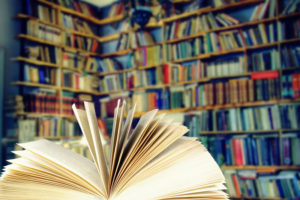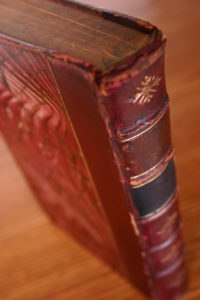Paradise as a Kind of Library

Jorge Luis Borges writes in his essay Blindness that he “had always imagined Paradise as a kind of library,” fondly recalling the many trips he took to the library with his father as a child, when he leafed through volumes of the Encyclopedia Brittanica and read whatever he came across. I am reminded of all that I have found in libraries – sometimes solace, sometimes hope, and always what I needed at the time.
Different libraries have marked my various life stages. Perhaps the most important library in my life was the Woodside branch of the Queens Public Library across the street from my grade school. The children’s room was upstairs in a loft overlooking the main adult reading room on the ground floor. At the top of the stairs straight ahead was a low table and tiny chairs near the picture books, and to the left were the longer tables at which the older kids sat. I spent many after-school hours at those long tables, doing homework, talking with friends, skimming countless books, and leafing through issues of Young Miss and American Girl. The library was a locus of activity throughout my elementary school days. I recall one particular fall afternoon in fifth grade — my friends and I started acting out a scene from this wonderful monthly periodical of children’s plays that was among the library’s subscriptions, prompting a “ssshh” from the librarian. The library was like our living room and sometimes we had to be reminded that it really wasn’t.
I became familiar with those shelves that housed my favorite authors, such as Laura Ingalls Wilder who wrote the Little House on the Prairie series that I gobbled down in second and third grades, and Judy Blume, author of Are You There God? It’s Me, Margaret and Deenie, whose books were a staple in my pre-teen years. Whenever I arrived at the library my first stop was at these favored spots on the shelves, to see if a volume that was missing the last time I was there had been returned. If I found a book I’d been waiting on, I grabbed it as if I just found the Hope Diamond.
In the fifth and sixth grades, I myself used the Encyclopedia Brittanica to do innumerable reports. When I had an assignment on a Native American tribe or endangered species or the suffragette movement, I journeyed downstairs into the adult reading room to use the encyclopedias kept in the reference section. But I would always return to my “home base” in the children’s section upstairs once I completed my research.
By junior high school, I “graduated” to the adult room on the main floor. I think it is quite fitting that the “young adult fiction” section was on the adult floor at the base of the stairs that led up to the children’s room. It’s as if the librarians consciously created a bridge between the children’s books and adult books, so the teenagers would not feel intimidated as they descended the stairs into the adult world. I sat among the senior citizens who came each day to read the latest copy of Time and Reader’s Digest, and the specialty newspapers published in the various languages spoken in our diverse neighborhood. Unlike the children’s section upstairs, there was a hush in the main reading room that was punctured only periodically by the large metal machine that photographed a patron’s library card against the label of each book borrowed.
As much time as I spent in that library during the school year, I think my favorite time to go was in the summer. As a child, the library was always cool and quiet, a relief from the undulating heat of the playground two blocks away where my sister and I would patiently wait our turn to bathe in the overcrowded city pool. Frank McCourt writes in Learning to Chill Out (in Inventing the Truth: The Art and Craft of Memoir, William Zissner, ed.) that the opening of a children’s library in his childhood hometown “was a feast for us.” The library of my youth was indeed a respite, from both heat and boredom, where I “researched” all the things I was going to do with my life, everything from how to wear makeup, to traveling to Paris, to becoming a journalist. There was simply a book for everything.
In 8th grade, my friend Karen was the first to suggest that we had outgrown our local branch in Queens and that we needed to go into the Manhattan where more resources were available. Much to my surprise our parents fell for this ploy. My small group of friends starting taking the subway into Manhattan on Saturday mornings to go the now-extinct Donnell branch of the New York Public library on 53rd Street, across from the Museum of Modern Art. I have no idea whose idea was it to go the Donnell instead of the better-known Midtown Manhattan branch or the Main Branch on 42nd Street with the two big lions in front. But looking back on it now, I think the Donnell was the perfect “transition” from our small local library. We probably would have been overwhelmed if we went into one of the bigger branches. Instead, the Donnell was just a bigger version of our local branch.
Being a bunch of nerdy kids, we actually did faithfully go to the library on those day trips into Manhattan. But we also made sure to go into lots of different stores on the leisurely walks to and from the Rockefeller Center station on the subway, which let us out right in front of Radio City Music Hall. And we always stopped off at a coffee shop or Chock Full O’Nuts for hamburgers and cokes, feeling quite cosmopolitan to be in Manhattan on our own on those blissful Saturday afternoons.
Eventually, my friends and I began commuting into Manhattan every day to attend high school. That’s when I “graduated” to the Main Branch at 42nd Street, indeed the mother of all libraries. McCourt’s description of his own experience at the Main Branch in Learning to Chill Out resonates with my feelings about that place:
But then I got to the main library at 42nd Street, which was the great discovery of my life – discovering that you can go into the library and nobody will bother you. In Limerick they were always throwing us out of the library. They acted like sentries, as if they were guarding the books against us. In New York I discovered – my God! – that you can get a library card and take out three of four books and you can take out books every day if you want. You can go up to the main reading room on the third floor and stay there all day, it used to be open on Sundays. I was in heaven.
At first, I spent a lot of time in the science room that housed the journals I needed for a research project. The science room was everything I thought a library should look like, at least from what I had seen in the movies. It was a long, narrow room lined with shelves of dark wood running the length of the room on each side and tall windows at the other end, with rolling ladders to access the books on the top most shelves. Overlooking the main area was a balcony that only the staff could access. Sometimes, I asked for a reference book just so that I could see the librarian mount the spiral staircase to the closed-off balcony.
But the most memorable part of the library was the main reading room that McCourt so lovingly describes. There were rows and rows of long, dark wood tables with these small, green reading lamps, the kind that had a little chain that pulled on to turn the lamp on. When I frequented the Main Branch in the 19702, they still used a system that I later saw in the movie Breakfast at Tiffany’s. First, you consulted the card catalogue (there was no computerized version yet) and filled out a slip of paper with the information of the book you wanted. You then took the slip of paper to the main desk, where they gave you a number. You sat and waited until your number lit up on this board above the main desk, like when you are on line at the bank or at Amtrak, waiting for the next available agent or teller. Seeing my number light up always made me feel as I had just won the door prize on a game show. I wonder what they do today.
But no matter what library I was in, there was always a common denominator. In each library, I tried on different versions of myself. In high school, as I mentioned above, I did a turn as a “scientist” and researched such things as the coming of the second ice age and the effect of barbiturates on cancer, only half understanding the highly technical language in the science journals. In graduate school at Columbia, following on my studies in college, I was a “Latin Americanist” in the library in the basement of the school of international affairs, reading sociological and anthropological studies with titles like “We Eat the Mines and the Mines Eat Us.” Later in law school at NYU, I looked up cases for a motion to suppress illegally seized evidence for my litigation class, as I prepared for my future career as a criminal defense lawyer.
I always find the sense of order in the hushed rooms a great comfort. It is one of the places where I feel competent, in control, but also where I feel that life has immense possibility. Libraries offer such an oasis of calm in the craziness that is my life. And now that some libraries even allow you to bring in coffee makes them perfect.


